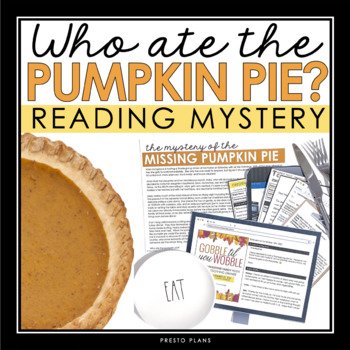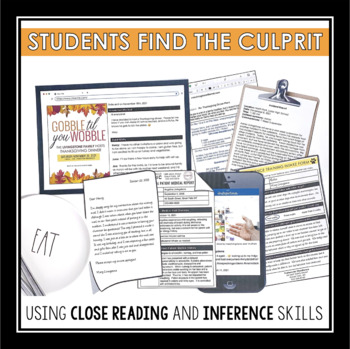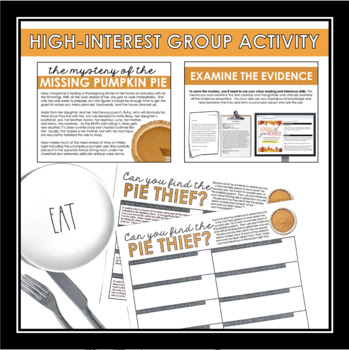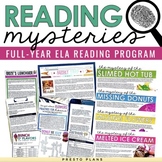Thanksgiving Close Reading Inference Mystery - Who Stole the Pumpkin Pie?
- Zip
What educators are saying
Also included in
- The Reading Mysteries Program is a full-year, 40-week close reading program for middle and high school English language arts teachers that challenges students to look for text evidence, infer information, and read more closely. It includes everything you need to facilitate 40 fun and engaging readinPrice $99.99Original Price $196.61Save $96.62
Description
Thanksgiving Close Reading Inference Mystery - Who Stole the Pumpkin Pie?: Engage your students with a captivating close reading inference activity that challenges them to explore and find text evidence, make inferences, and read more closely. This resource provides all the necessary materials to facilitate this fun and creative reading activity in your classroom. Students will have the opportunity to work collaboratively, enhancing their problem-solving and critical-thinking skills as they unravel the mystery together.
Mary is hosting the family Thanksgiving dinner, and when she takes the topper off to reveal the delicious pumpkin pie, it is gone! Someone has eaten the whole thing, and it's up to your students to determine who was the most likely culprit.
This is included in our best-selling full-year program:
Included In This Thanksgiving Close Reading Inference Mystery Activity:
➡️ Inference Mystery Presentation Slides: This 15-slide PowerPoint presentation serves as the guide for the activity, leading students through the mystery with a captivating backstory, detailed evidence, and thorough explanations for each suspect's innocence or guilt. The slides are crafted to engage students and encourage critical thinking as they analyze the clues and find text evidence.
➡️ Classroom Poster: Display this visually appealing poster designed to grab students' attention as they enter the classroom, setting the stage and drawing students into the mystery ahead.
➡️ Original Narrative Backstory: Use this short story to introduce the mystery. Within the story are hidden clues and subtle hints, and the narrative will engage students' curiosity and initiate the mystery.
➡️ A Variety of Clues and Evidence: Students will receive a variety of texts in different forms that include clues and evidence. Students must read the text closely and use their inference skills to analyze each of the clues. There is a letter, a school incident report, a medical record, email conversation, obedience school intake form, text message, social media post, and an evite with an RSVP message board.
➡️ Text Evidence Graphic Organizer: Students will use the provided graphic organizer to organize their findings and evaluate the guilt or innocence of each suspect. This tool encourages students to support their conclusions with text evidence from the investigation.
➡️ Teacher Answer Key: Use the detailed answer key, both in print format and integrated into the presentation slides, to efficiently review students' work and share the reasons for each suspect's innocence or guilt.
How The Thanksgiving Close Reading Inference Mystery Activity Works:
- Start by putting up the poster on your door to build anticipation when students enter the room. When students enter, put them in small groups, so they can work together to try to solve the mystery.
- Use the presentation slides to guide you through each element of the lesson. The slides will help you introduce the story and evidence to each of the groups.
- Hand out all the evidence to students and allow them time to make their predictions and inferences and solve the mystery.
- Once each group has made their final prediction, use the presentation slides to reveal the culprit and go through each of the suspects to show the evidence of their innocence or guilt.
What Teachers Are Saying About The Thanksgiving Close Reading Inference Mystery Activity:
⭐️⭐️⭐️⭐️⭐️ My students had a blast finding out "whodunnit" right before Thanksgiving break. It was easy for me to hand to my students and simple grading with the graphic organizer in the packet. It was also a great way to get students to pull out specific evidence, meeting common core standards. It seemed like there was a purpose for finding the evidence, not just because the teacher said so, or because you have to write an essay.
⭐️⭐️⭐️⭐️⭐️ My students really enjoyed working collaboratively to figure out the mystery of the pie. The material was engaging and students had to use inferencing skills to put the pieces together. The tracking sheet at the end was helpful for students to use and clear up misconceptions along the way. I will use this again!
⭐️⭐️⭐️⭐️⭐️ My students LOVED this! I also raised the stakes by telling them that the first group to get the correct answer would get pie the next day and that immediately made it more intense. Highly recommend!
If you like this, you’ll love this resource:
>>> Inference Activities Bundle
© Presto Plans
➡️ Want 10 free ELA resources sent to your inbox? Click here!
⭐️ Follow Presto Plans on TpT to see what's new and on sale.






